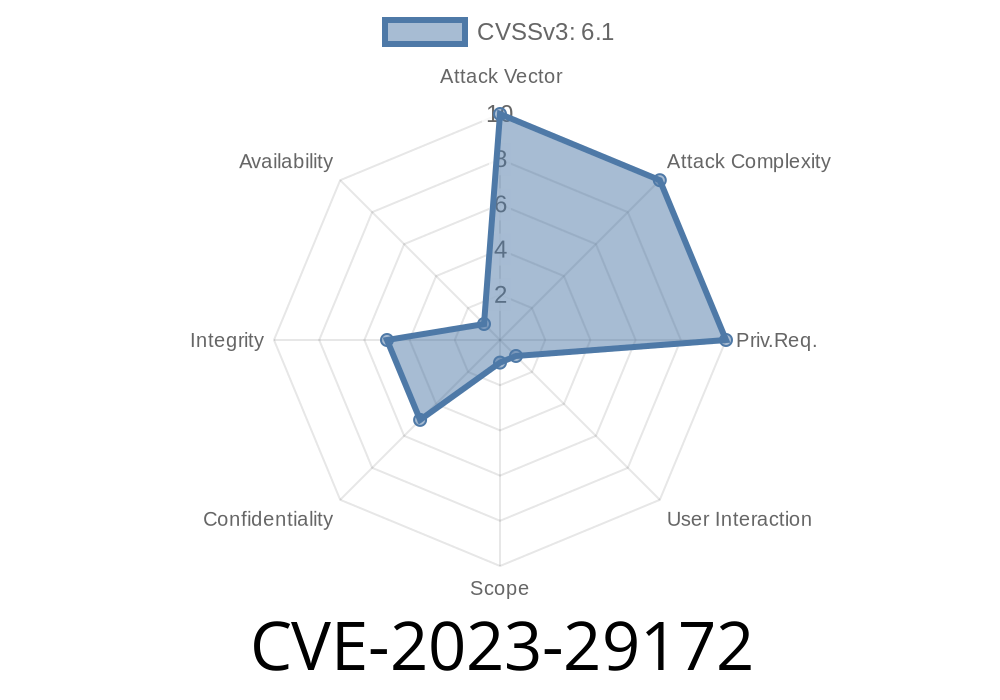---
If you’re running a WordPress site relying on the popular PropertyHive plugin to manage properties and listings, take a moment to check your current plugin version. A critical security vulnerability tracked as CVE-2023-29172, discovered in versions up to and including 1.5.46, could put your website and its visitors at significant risk.
In this article, we’ll break down what this vulnerability means, walk you through how it works, show a proof-of-concept exploit, reference reputable sources, and explain how you can secure your website—fast. No jargon here, just straight talk.
🚨 What is CVE-2023-29172?
This CVE relates to a reflected Cross-Site Scripting (XSS) vulnerability that requires no user authentication—meaning anyone can target it, not just logged-in users.
What’s Reflected XSS?
Reflected XSS is a web security bug where an attacker tricks your site into “reflecting” dangerous JavaScript code back to visitors through URL parameters or form inputs. When victims click a malicious link, rogue code runs in their browsers.
In CVE-2023-29172, the vulnerability sits in how the PropertyHive plugin fails to properly sanitize user-supplied input sent via certain URL parameters, allowing attackers to inject arbitrary JavaScript.
🔍 Technical Details
The vulnerability exists because the plugin outputs unsanitized GET parameters directly into the page, specifically during property search or listing functions.
Here’s a simplified look at a vulnerable code pattern (based on real-world analysis)
// Vulnerable code snipplet (for illustration)
$location = $_GET['location'];
echo '<input type="text" name="location" value="' . $location . '" />';
If $_GET['location'] is not sanitized, an attacker could craft a URL like this
https://your-site.com/properties/?location="><script>alert('XSS')</script>;
Result: The attacker’s JavaScript (alert('XSS')) executes immediately in the browser—no authentication required!
🧑💻 Proof of Concept (PoC) Exploit
Let’s see what an actual exploit would look like for a site running PropertyHive <= 1.5.46.
Example Exploit Link
https://victim-site.com/properties/?location=%22%3E%3Cscript%3Ealert('XSS')%3C/script%3E
`html
alert('XSS')
<br>- The script tag executes—showing the classic XSS pop-up as proof.<br><br><b>No login is needed to make this work.</b><br><br>---<br><br>### 🔓 Why is This Dangerous?<br><br>- <b>Phishing</b> – Attackers can steal cookies or login tokens.<br>- <b>Session Hijacking</b> – Take control of logged-in user sessions, including admins.<br>- <b>Defacement</b> – Inject bogus content or redirect visitors.<br>- <b>Malware Delivery</b> – Trick users into downloading dangerous files.<br><br>All of this, just from clicking a malicious link.<br><br>---<br><br>### 🛡️ Mitigation: How To Fix<br><br><b>Update Immediately</b> <br>The PropertyHive maintainers patched this bug in later versions. To protect your site:<br><br>1. <b>Update PropertyHive</b> to the latest version (at least 1.5.47, preferably newer).<br>2. Review and sanitize any plugin customizations.<br>3. Consider adding a Web Application Firewall (WAF) for added protection.<br><br><b>Never trust user input</b> when echoing back into HTML — always use functions like esc_attr($input) or htmlspecialchars()` in PHP.
---
### 📚 References & Further Reading
- NVD: CVE-2023-29172
- PropertyHive Official Blog: Security Releases
- WPScan Advisory: PropertyHive <= 1.5.46 - Reflected XSS
- OWASP: Cross-site Scripting (XSS) Explained
---
### 🚀 Wrapping Up
CVE-2023-29172 is a serious, easy-to-exploit reflected XSS bug in the PropertyHive plugin. If you’re running a vulnerable version, an attacker can hijack user sessions or worse. Patch immediately, and always sanitize your inputs!
Stay safe—check your versions, keep your plugins updated, and educate your users about phishing and suspicious links.
---
Did you find this article useful? Share it with your fellow WordPress admins and help secure the community!
Timeline
Published on: 04/07/2023 15:15:00 UTC
Last modified on: 04/13/2023 17:29:00 UTC
